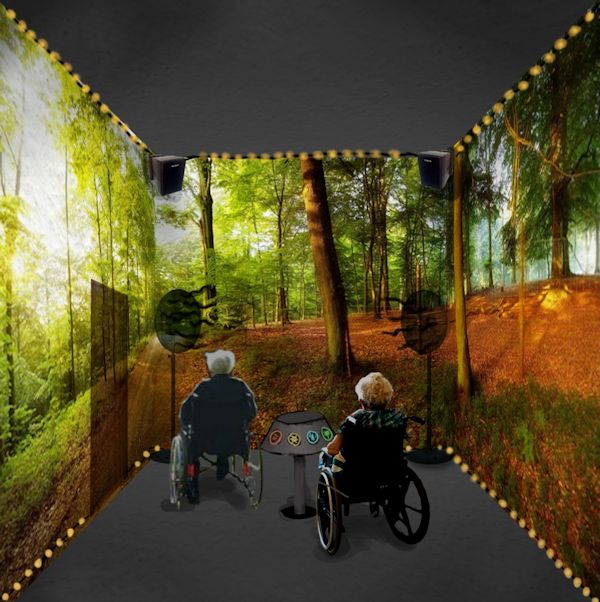[From The Daily News of Newburyport, Massachusetts; more about the UMass Lowell SLICE program is available here and the detailed proposal for the sensory room is in a Word file here]
A sense of reality
New projects bring beach, ballpark to those with disabilities
By Bruno Matarazzo Jr., Staff writer
May 21, 2012
AMESBURY — The noise inside Coastal Connections’ Lower Millyard facility can be loud at times with all the activities happening at once.
The open space at the nonprofit school in Amesbury bustles with energy as students with an array of disabilities work together with staff on different exercises and games.
Sometimes, the students just need a quiet space.
Enter the sensory room.
Thanks to a group of soon-to-be engineering graduates from UMass Lowell, an empty room furnished with only a chair and bare walls can now be a beach, a forest, an aquarium, a coffee shop, a boat or even McDonald’s.
“Our project is a virtual reality sensory room,” said Bonie Rosario Jr., one of five students at UMass Lowell who worked on the project.
“It allows one of the users to press one of these six outer buttons that transform the entire room into a virtual scene.”
The words “virtual reality” may conjure up images of someone putting on a pair of specialized glasses to transport them elsewhere.
Instead, Rosario and fellow students Katherine Aho, Jenny Au, Haixin Li and Sebastian Osorio installed projection screens around the room to provide an IMAX theater experience.
When one of Coastal Connections’ students wants to take a trip to the beach, mist machines will simulate the feel of the ocean mist, a gentle fan will blow a cool breeze, coconut-scented oil will provide a tropical aroma and LED rope lights will create the glow of the setting sun.
Not all of the features activate with each scene. There’s no mist, for example, at McDonald’s. But Coastal Connections’ students can turn it on at any time with the push of a button.
The sensory devices work with the aid of a computer connected to a wireless transceiver. When the various buttons are pushed, data is transmitted from the computer, purchased through a grant from Newburyport Five Cents Savings Bank, to the devices scattered across the room.
The UMass Lowell students worked for a year on the project, spending the first semester brainstorming and crafting their project and then the second semester building and configuring all the devices to work properly. The hard part came last Thursday and Friday when they had to install all the devices and put everything together.
Rosario said they came up with the idea after learning of the empty space at Coastal Connections, but they’ve taken the project one step further.
“That was really our brainstorming idea, turn this project from an academic requirement to something we really wanted to do for the sake of helping people,” Rosario said.
Rosario said he and his fellow students want to turn their project into a nonprofit business. They are applying for grants and looking to get more resources while working on their business plan. They hope not only to help individuals with disabilities enjoy places they otherwise would not be able to, but also allow them the opportunity to relax with the help of a multi-sensory experience.
The sensory room isn’t the only project to benefit from the work of students from UMass Lowell. Graduating seniors in the college’s SLICE program, which stands for Service-Learning Integrated throughout the College of Engineering, are completing projects across the world. The College of Engineering made the SLICE program a requirement in 2005, according to university spokeswoman Christine Gillette.
There are a variety of projects students can choose from to help the community, including the Assistive Technology Program where engineering students design and build games or devices to aid people with special needs and the organizations that serve them, like Coastal Connections.
Deborah Plumer, Coastal Connections’ co-executive director, said the engineering students have been designing devices for her clients since 2005.
In another part of Coastal Connections last week, students John Foley, Dave Cote and Jason Riordan created a sensory driving simulator that gives students unable to drive a car the chance to experience the feel of being behind the wheel.
Their device involves a vibrating steering wheel that commands a car on the computer monitor. It also includes buttons that play music from the radio and a fan to give the illusion of the wind coming through a window.
Kevin Ryan of Methuen, who is in a wheelchair, took the sensory driving simulator for a test drive last week.
“Kevin cannot drive a car, but he can get that experience using this technology,” Plumer said.
While driving a car on a computer screen might seem like the goal of the program, it’s actually the auditory, tactile and visual feedback the students receive that provide the most benefit, Plumer added.
In another part of the room, Kyle Moulton, Jason Duva and Sambath Kol showed off their home run derby baseball game that allows Coastal Connections students to either swing a plastic bat or push a button. If the students initiate action at just the right time, it’s a home run. If not, it’s an out. A gyroscope and accelerometer inside the bat measure how fast they swing.
“The game is designed to incentivize the use of the client’s upper body,” Moulton said.
A home run prompts footage of Red Sox players hitting a home run at Fenway Park and an out triggers similar footage, as if the person at the wheel were actually at the ballpark.
“It’s an awesome partnership and these guys benefit so much,” Plumer said.
